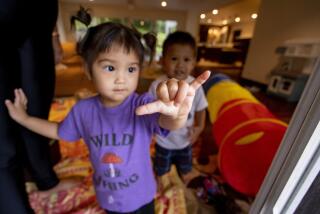That Certain Mys-Tiki
- Share via
If Josh Agle could have a hut for a home, he’d indulge in luaus. Instead, the artist; his wife, Glen; and their 2-year-old daughter, Zoey, live in a ‘50s-era house smack in the middle of historic Orange.
But in homage to Agle’s love of the tropics, the home is decorated in tiki to the max.
The tropical madness starts in the frontyard--a grimacing face of a tiki god peers into the street--and continues throughout the red-trimmed tract home.
Walking inside is like stepping into one of Agle’s canvases, which capture the swank style’s enduring icons: blowfish lamps, monophonic hi-fis and Polynesian gods.
In the living room of the 2,000-square-foot home are tribal masks as well as miniature to life-size totems that glare devilishly from every wall and corner. A martini bar with faux leopard fur and black Formica top stands against one wall. A black egg chair made by Swedish designer Arne Jacobsen is at the center next to a purple bird chair.
The Agles’ home furnishings are treasures they salvaged from thrift stores, flea markets and garage sales. Many of the items were discarded after tiki’s popularity declined in the ‘70s.
“It was cheaper than going to Ethan Allen and it was much more our taste,” said Josh Agle, 38. “Since we’ve been collecting, there’s been a huge resurgence in the style. It’s cyclical. People of my generation were growing up when this stuff had its appeal.”
Tiki has indeed become trendy again, making waves at vintage stores and auction houses, including EBay online, and collector and fanzines such as the San Francisco-based Tiki News.
Tiki is a Maori word that refers to carvings of stone or wood, traditionally palm tree trunks, that depict a Polynesian god. The term has since been expanded to describe the decorative style of tropical-themed restaurants and watering holes graced by these figures.
Tiki icons typically have menacing scowls and open mouths, sometimes showing a wicked set of dagger-like teeth.
Agle, a.k.a. Shag (the last two letters of his first name and first two letters of his last name), caught Polynesian fever 15 years ago when he started to collect tiki mugs.
He found his first one at a thrift store in Long Beach, where he attended college.
“I knew they were connected to Polynesian cocktail lounges and they were tropical, but I didn’t know much more about it,” said Agle, who graduated with a fine arts degree and worked as a graphic designer and illustrator for local record labels. “It just seemed old-fashioned and mysterious.”
On display in his home art studio are 200 multicolored, distinct tiki mugs he’s found over the United States.
“That’s what hard-core collectors do,” Agle said, wearing a Hawaiian shirt. “You want to have the biggest, baddest collections.”
Agle’s affinity for the tropics preceded his first mug. He and his wife met in the 1980s, when Agle was part of a band that played folk, calypso and alternative-style music. The band’s name? “Swamp Zombies.”
The couple married a decade ago and moved into the house three years ago. “This house won us over really fast,” said Glen, 33.
*
Dark, hardwood floors lead from the entrance to the family recreation den and dining room, separated by a Japanese sliding shoji screen.
The family room is lined with wood paneling, a built-in fireplace and brick window seats painted white. The couple plan to juice up the Japanese flair with lanterns and parasols.
They say that while they love the tiki decor, they may remodel the house and experiment with a more Japanese design and theme, and that probably means a few more trips to the secondhand shops.
* Vivian LeTran can be reached at (714) 966-5835 or by e-mail at vivian.letran@latimes.com.


